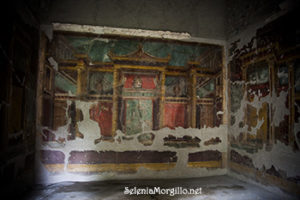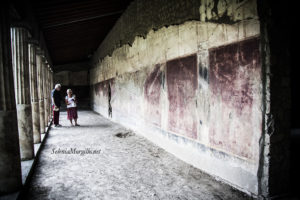79 d.C., Oplontis
Italian Version Below*
Oplontis stands in the modern Torre Annunziata (Naples).
With the eruption of the Somma (the Vesuvius of which we always speak, erroneously, formed after the eruption from the ancient crater of the Somma) of 79 AD, followed the fate of Pompeii, Herculaneum, and Stabiae.
The first excavation campaigns were carried out in the eighteenth century (Bourbon period), but only in the twentieth century, systematic excavations, brought to light in 1964 the cd. Villa di Poppea, and in 1974 a rustic villa attributed to L. Crassius Tertius.
Only can be visited Villa di Poppea, which is grandiose in size and quality of the frescoes, made up of masks, fruit baskets, torches, and birds.
Attributed to Poppea Sabina second wife of Nero for an inscription painted on an amphora, addressed to Secundus, freed from Poppea, it is evident that in any case, it must have belonged to the very rich patrimony of the imperial family which, like many exponents of the Roman patriciate, preferred the Campania coast famous for its healthy climate.
Built around the middle of the first century BC, it covered 11000 m2, and 1/3 is still to be excavated.
In the area in the light, archaeologists have rediscovered 100 rooms, including a thermal sector, and a swimming pool (17X61) (partially excavated) which was to be decorated with statues.
At the time of the eruption, the house was uninhabited, being renovated following the numerous seismic events that hit the Vesuvian area (the earthquake of 62 AD was destructive).
All rights reserved*
Oplontis sorge nella moderna Torre Annunziata (Napoli).
Con l’eruzione del Somma (il Vesuvio di cui si parla sempre, erroneamente, si è formato dopo l’eruzione dall’antico cratere del Somma) del 79 d.C., seguì le sorti di Pompei, Ercolano, e Stabiae.
Le prime campagne di scavi furono effettuate nel XVIII secolo (periodo borbonico), ma solo nel XX secolo, scavi sistematici, riportarono alla luce nel 1964 la cd. Villa di Poppea, e nel 1974 una villa rustica attribuita a L. Crassius Tertius.
E’ visitabile solo la Villa di Poppea, grandiosa per dimensioni e per la qualità degli affreschi, costituiti da maschere, cesti di frutta, fiaccole e uccelli.
Attribuita a Poppea Sabina seconda moglie di Nerone per un’iscrizione dipinta su di un’anfora, indirizzata a Secundus, liberto di Poppea, è evidente che in ogni caso doveva appartenere al ricchissimo patrimonio della famiglia imperiale che come molti esponenti del patriziato romano, prediligeva la costa campana famosa per la salubrità del clima.
Costruita intorno alla metà del I secolo a.C., copriva 11000 m2 ed 1/3 è ancora da scavare.
Nella zona in luce gli archeologi hanno riscoperto 100 ambienti, comprendenti anche un settore termale, ed una piscina (17X61) (parzialmente scavata) che doveva essere decorata da statue.
Al momento dell’eruzione la casa era disabitata, in ristrutturazione in seguito ai numerosi eventi sismici che colpirono l’area vesuviana (distruttivo il terremoto del 62 d.C.).
Dove trovarla: QUI
Info e prenotazioni: QUI
Sostieni la #culturachevince, aiuta la condivisione.

